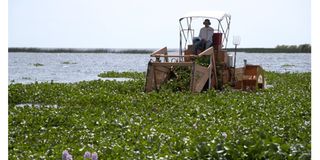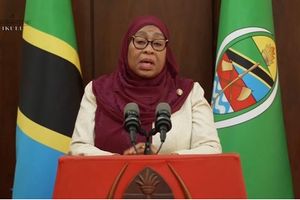Experts discover new type of water hyacinth in Lake Victoria

What you need to know:
- This invasive species can reproduce two to three times every eight days, leading to rapid growth in a short period of time.
A new type of water hyacinth, Salvinia spp, has been identified in Lake Victoria.
This invasive species can reproduce two to three times every eight days, leading to rapid growth in a short period of time.
Over 36 tons of Salvinia spp have already been removed from the Kigongo-Busisi area.
Speaking to journalists on Sunday, March 2, 2025, Jarome Kayombo, Manager of the Lake Victoria Zone for the National Environment Management Council (NEMC), explained that the primary cause of the water hyacinth's rapid reproduction is the increased nutrient levels in the lake.
He attributed this to human activities, such as poor environmental management practices.
"In August 2024, fishermen in Buyagu in Sengerema District, Chole, Nyahiti, and Mbarika in Misungwi District began noticing the new Salvinia spp water hyacinth. Reports suggest the species spread across various areas depending on wind direction," Kayombo said.
By January 2025, the rapid growth of this water hyacinth began to have significant impacts on the fishing sector and transportation, particularly affecting ferries operating in the Kigongo-Busisi area. This has disrupted transport services between Mwanza Region and other areas relying on ferry transport.
In response to the growing problem, the Mwanza Regional Commissioner’s office formed a task force that included experts from NEMC, the Lake Victoria Basin Water Board (LVBWB), the Plant Health Authority (TPHPA) in the Lake Zone, the Fisheries Research Institute (TAFIRI), and the Mwanza Fisheries College. The task force’s objective was to identify the species of water hyacinth and devise immediate solutions.
The task force also included experts from the Fire and Rescue Service, Misungwi and Sengerema District Councils, TAMESA, NGOs, and Beach Management Units (BMUs).
“The task force successfully identified the species, studied its reproductive habits and spread, and removed over 36 tons of the water hyacinth from the Kigongo-Busisi area,” Kayombo said.
He explained that the rapid spread of Salvinia spp is driven by various human activities, such as agriculture, improper disposal of waste (both liquid and solid) from industries and households, construction, fishing, and fish farming practices that neglect environmental management guidelines. He also noted that hotels and industries along the lake, lacking proper waste disposal infrastructure, contribute to the problem.
Other factors contributing to the spread include deforestation, mining activities that disregard sustainable development, and encroachment within the 60-meter buffer zone along riverbanks or lake shores. These activities increase nutrient levels in the lake, accelerating the growth of water hyacinth.
In addition to the visible damage, Kayombo highlighted the negative effects of the water hyacinth on aquatic life, particularly fish. The plant depletes oxygen levels in the water, reduces water quality, and affects fish farming, transport, and biodiversity.
He added, “In short, Salvinia spp poses significant threats to the fishing industry, lake transport services, clean water supply, tourism, and human health. Therefore, collective efforts from the government, NGOs, international organizations, development partners, and local communities are necessary to address these environmental and social challenges.”
To tackle the issue, NEMC, in collaboration with stakeholders, is ensuring that investments along and within Lake Victoria comply with national laws, including conducting environmental impact assessments before starting any projects to minimize pollution in the lake.
The council has developed a comprehensive plan and has already conducted 134 inspections around Lake Victoria, focusing on industries, farms, hotels, mines, and wastewater and solid waste management facilities to identify pollution sources.
"NEMC has also developed an inspection and awareness program for fish farmers to ensure compliance with legal requirements and proper environmental practices, including respecting the area's carrying capacity," Kayombo explained.
He emphasized that NEMC, in collaboration with LVBWB and local government authorities, will continue enforcing the 60-meter buffer zone rule as outlined in the 2004 Environmental Law and its regulations. This buffer zone is crucial for filtering pollutants, especially during the rainy season, and helps reduce pollution in the lake.
"NEMC strongly warns investors along or within Lake Victoria who fail to meet legal requirements. For instance, investments made without conducting an environmental impact assessment, the only process that ensures all stakeholders, including local communities, are involved, can result in poorly managed projects and potential harm," Kayombo added.
A fisherman from Luchelele, Kulwa Joseph, called for immediate action from various stakeholders to eliminate the invasive species, as it threatens fish breeding grounds. The presence of Salvinia spp is forcing fish, such as Nile perch, to migrate to deeper waters, making them harder to catch.





